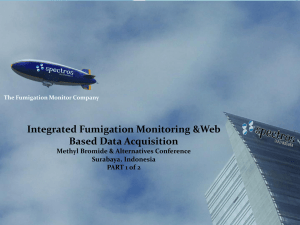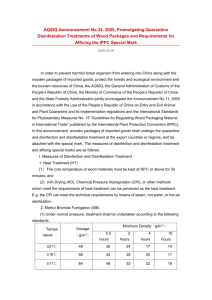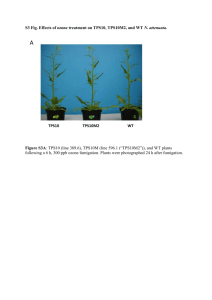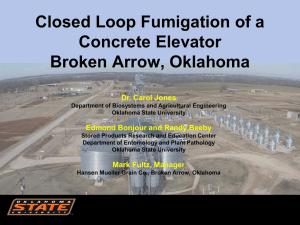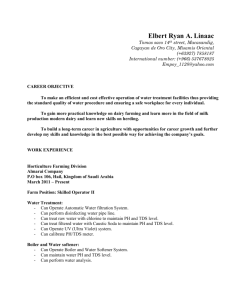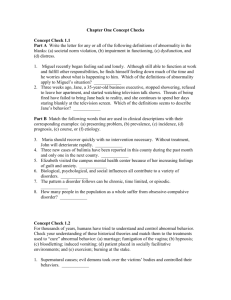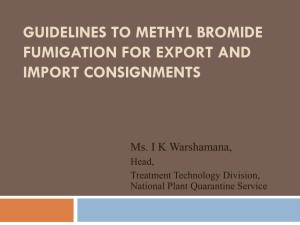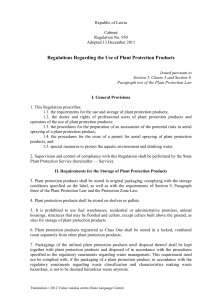2.19 Fumigation of Grain Vessels
advertisement
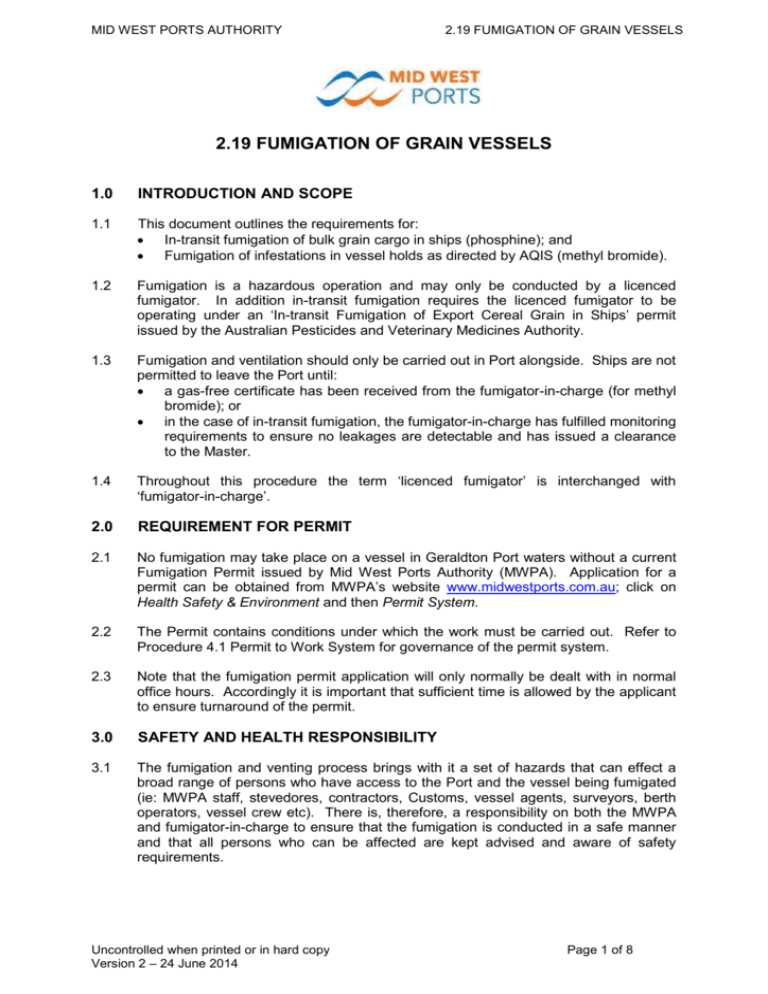
MID WEST PORTS AUTHORITY 2.19 FUMIGATION OF GRAIN VESSELS 2.19 FUMIGATION OF GRAIN VESSELS 1.0 INTRODUCTION AND SCOPE 1.1 This document outlines the requirements for: In-transit fumigation of bulk grain cargo in ships (phosphine); and Fumigation of infestations in vessel holds as directed by AQIS (methyl bromide). 1.2 Fumigation is a hazardous operation and may only be conducted by a licenced fumigator. In addition in-transit fumigation requires the licenced fumigator to be operating under an ‘In-transit Fumigation of Export Cereal Grain in Ships’ permit issued by the Australian Pesticides and Veterinary Medicines Authority. 1.3 Fumigation and ventilation should only be carried out in Port alongside. Ships are not permitted to leave the Port until: a gas-free certificate has been received from the fumigator-in-charge (for methyl bromide); or in the case of in-transit fumigation, the fumigator-in-charge has fulfilled monitoring requirements to ensure no leakages are detectable and has issued a clearance to the Master. 1.4 Throughout this procedure the term ‘licenced fumigator’ is interchanged with ‘fumigator-in-charge’. 2.0 REQUIREMENT FOR PERMIT 2.1 No fumigation may take place on a vessel in Geraldton Port waters without a current Fumigation Permit issued by Mid West Ports Authority (MWPA). Application for a permit can be obtained from MWPA’s website www.midwestports.com.au; click on Health Safety & Environment and then Permit System. 2.2 The Permit contains conditions under which the work must be carried out. Refer to Procedure 4.1 Permit to Work System for governance of the permit system. 2.3 Note that the fumigation permit application will only normally be dealt with in normal office hours. Accordingly it is important that sufficient time is allowed by the applicant to ensure turnaround of the permit. 3.0 SAFETY AND HEALTH RESPONSIBILITY 3.1 The fumigation and venting process brings with it a set of hazards that can effect a broad range of persons who have access to the Port and the vessel being fumigated (ie: MWPA staff, stevedores, contractors, Customs, vessel agents, surveyors, berth operators, vessel crew etc). There is, therefore, a responsibility on both the MWPA and fumigator-in-charge to ensure that the fumigation is conducted in a safe manner and that all persons who can be affected are kept advised and aware of safety requirements. Uncontrolled when printed or in hard copy Version 2 – 24 June 2014 Page 1 of 8 MID WEST PORTS AUTHORITY 2.19 FUMIGATION OF GRAIN VESSELS 4.0 KEY RISKS 4.1 Accidental release of fumigant. This could result in poisoning of the fumigation operator/s, vessel crew and other persons in the vicinity as well as potentially environmental damage (fumigants are very toxic to aquatic organisms). 4.2 Release of gas during venting process (methyl bromide). Part of the fumigation process following an infestation treatment is to aerate hatches to allow the remaining fumigant to be released to the environment. There is a risk that the remaining fumigant being heavier than air can drop to work areas where persons may be working. There is also a risk that the fumigant could be blown over and onto a work area. 4.3 Inappropriate Personal Protective Equipment (PPE) is used. Fumigants are extremely dangerous to human life and therefore there are specific requirements for PPE for those involved in the fumigation process. 4.4 Unauthorised entry into fumigation area. There is a risk of unauthorised persons entering the fumigation exclusion zone. 5.0 FUMIGATION STANDARDS 5.1 Fumigation at Geraldton Port must be conducted in accordance with: 1. 2. 3. 4. 5. The Australian Pesticides & Veterinary Medicines Authority Permit (APVMA) (for phosphine); WA Health (Pesticides) Regulations 2011; IMO Recommendations on the Safe Use of Pesticides in Ships Applicable to the Fumigation of Cargo Holds; AS2476-2008 General fumigation procedures; Any other relevant legislation, permit or licence condition. 5.2 In relation to fumigation with methyl bromide, where there is conflict between the requirements, the Health (Pesticides) Regulations 2011 would preside. 6.0 INCIDENTS, BREACH OF FUMIGATION PERMIT OR PROCEDURE 6.1 All incidents relating to fumigation of vessels and any breach of MWPA’s fumigation requirements will be formally reported to Executive Director Public Health (Department of Health WA), Australian Pesticides & Veterinary Medicines Authority, Australian Maritime Safety Authority and Department of Mines & Petroleum (if the affected area is a mine site) as the case may be. 6.2 Subject to the severity of the incident or breach, the fumigator and/or firm may be precluded from any future fumigation work at the Port or have access to the Port denied. 7.0 PROCEDURES 7.1 Attachment A attached to this procedure outlines specific requirements for in-transit fumigation with phosphine. Uncontrolled when printed or in hard copy Version 2 – 24 June 2014 Page 2 of 8 MID WEST PORTS AUTHORITY 2.19 FUMIGATION OF GRAIN VESSELS 7.2 Attachment B attached to this procedure outlines the requirements for fumigation of an infestation with methyl bromide. 8.0 REFERENCES Australian Maritime Safety Authority, In-transit fumigation of ships cargoes, Marine Notice 4/2009 Australian Maritime Safety Authority, Marine Orders Part 33 (Cargo and cargo handling – grain) 2005 International Maritime Organisation (IMO) – Recommendations on the safe use of pesticides in ships, MSC.1/Circ.1264, 27 May 2008 Australian Quarantine and Inspection Service (AQIS) - Treatments and fumigants – AQIS Methyl Bromide Fumigation standard (Version 1.6 March 2011) Australian Maritime Safety Authority, In-Transit Fumigation of Ships Cargoes, Marine Notice 4/2009 Material Safety Data Sheet (MSDS) – Methyl Bromide Material Safety Data Sheet (MSDS) - Phosphine WA Department of Health, Guidelines for the safe use of pesticides in non-agricultural workplaces WA Health (Pesticides) Regulations 2011 9.0 ADMINISTRATION Custodian: HSEQ Manager & Harbourmaster Approved: Peter Klein Chief Executive Officer 23 June 2014 Uncontrolled when printed or in hard copy Version 2 – 24 June 2014 Page 3 of 8 MID WEST PORTS AUTHORITY 2.19 FUMIGATION OF GRAIN VESSELS ATTACHMENT A PROCEDURE FOR FUMIGATION WITH PHOSPHINE (IN-TRANSIT FUMIGATION OF GRAIN CARGO) 1. Application to Fumigate Once the need to fumigate is determined the fumigator-in-charge must lodge an application for a permit to fumigate with the MWPA as soon as possible after the requirement is identified. A copy of the fumigator’s licence and the APVMA permit will need to accompany the permit application. Fumigation shall not commence until a MWPA Permit to Fumigate has been issued in writing and all conditions outlined in the Permit have been met. 2. Fumigation Plan The fumigator is required to have in place a fumigation plan that covers off the topics outlined in section 2.2 of AS2476 General fumigation procedures. The fumigation plan must be completed for each fumigation, but can be based on a generic document. 3. Risk Assessment A risk assessment shall be completed for each fumigation to determine any hazards which may be present, the potential consequences and the appropriate controls measures. Where the fumigation being carried out is similar to previous work in terms of location, material, goods, etc. a generic risk assessment may be used as a basis, with the addition of any hazards specific to the particular job, in consultation with relevant site personnel. The risk assessment must include all possible hazards associated with the particular fumigation job and as a minimum must cover off on the issues outlined in section 2.3 of AS2476. 4. Approval for Immobilizing Vessel All personnel, except the ship’s crew and those persons involved in the fumigation process, shall either remain in the accommodation or have disembarked the vessel prior to fumigation. Crew members remaining on board should remain indoors. Where it is proposed that the ship is to become immobilized or unmanned, specific approval must be obtained from MWPA’s Harbour Master to ensure that the ship is safe. 5. Advice to Others in the Area In accordance with APVMA Permit conditions, the vessel’s agent shall notify persons intending to visit the vessel that fumigation will be taking place on board and access may be restricted. This includes stevedores, wharf personnel, contractors, surveyors, government officials and the like. Uncontrolled when printed or in hard copy Version 2 – 24 June 2014 Page 4 of 8 MID WEST PORTS AUTHORITY 6. 2.19 FUMIGATION OF GRAIN VESSELS Watchperson to be Posted It is the responsibility of the fumigator-in-charge to ensure a watchperson is posted at the gangway to prevent unauthorized boarding or entry. Clear instructions must be given to the watchman by the Master or fumigator-in-charge about his/her duties. They must also be advised of what to do in an emergency and contact numbers should an emergency occur. 7. Disembarking fumigation contractors at the anchorage Specific approval must be obtained from MWPA’s Harbour Master where it is intended to disembark fumigation contractors at anchorage. This must be done prior to the vessel berthing. Approval will not normally be granted unless wind and sea states are moderate and the contractor is able to provide evidence of training in ship to launch transfer procedures. 8. Disposal of fumigation packing Any waste packaging from the fumigation process is to be removed from site and disposed of appropriately by the fumigator. 9. Clearance Prior to the Marine Pilot boarding the vessel and the vessel setting sail, the fumigator-incharge must have fulfilled all monitoring requirements to ensure no leakages are detectable and have issued a clearance to the Master. Uncontrolled when printed or in hard copy Version 2 – 24 June 2014 Page 5 of 8 MID WEST PORTS AUTHORITY 2.19 FUMIGATION OF GRAIN VESSELS ATTACHMENT B PROCEDURE FOR FUMIGATION (TREATMENT OF AN INFESTATION) 1. WITH METHYL BROMIDE Application to Fumigate Once the need to fumigate is determined the fumigator-in-charge must lodge an application for a permit to fumigate with the MWPA as soon as possible after the requirement is identified. A copy of the fumigator’s licence will need to accompany the permit application. Fumigation shall not commence until a Permit to Fumigate has been issued in writing and all conditions outlined in the Permit have been met. 2. Fumigation Plan The fumigator is required to have in place a fumigation plan that covers off the topics outlined in section 2.2 of AS2476 General fumigation procedures. The fumigation plan must be completed for each fumigation, but can be based on a generic document. 3. Risk Assessment A risk assessment shall be completed for each fumigation to determine any hazards which may be present, the potential consequences and the appropriate controls measures. Where the fumigation being carried out is similar to previous work in terms of location, material, goods, etc. a generic risk assessment may be used as a basis, with the addition of any hazards specific to the particular job, in consultation with relevant site personnel. The risk assessment must include all possible hazards associated with the particular fumigation job and as a minimum must cover off on the issues outlined in section 2.3 of AS2476. 4. Safety of Vessel Crew The Master is to be provided with written instructions by the fumigator-in-charge on the type of fumigant used, hazards to human health involved and the precautions to be taken. It is the fumigator’s responsibility to ensure the Master understands the instructions and has passed this onto the crew. Evacuation of the space under gas treatment is mandatory. The WA Health (Pesticides) Regulations 2011 requires that the fumigator ensure all doors, windows and other means of access to the fumigation area are closed and securely fastened and a warning sign is attached to each door, window and access point. The fumigator is responsible for ensuring the Master is aware that crew on board the vessel: 1. must remain in an area on the vessel that is away from the area being fumigated; 2. are to be trained in using the required respiratory protective equipment and have access to that equipment; 3. know what gas is being used and understand the risks; 4. know what first aid treatment is required; and 5. have on board an instrument capable of monitoring gas levels. Uncontrolled when printed or in hard copy Version 2 – 24 June 2014 Page 6 of 8 MID WEST PORTS AUTHORITY 2.19 FUMIGATION OF GRAIN VESSELS Fumigation shall not commence until the fumigator by personal inspection, has ascertained that no person is within any part of the vessel to be treated with fumigant and this has been confirmed by the Master. Where it is proposed that the ship is to become immobilized or unmanned, specific approval must be obtained from MWPA’s Harbour Master to ensure that the ship is safe. 5. Determination of Exclusion Zone During Ventilation As part of the risk assessment, the area to be evacuated and kept clear during ventilation of the hold after fumigation (the ‘exclusion zone’ or ‘risk area’), is to be determined by the fumigator. This is to be noted on the Permit Application. It is the fumigator’s responsibility to ensure that adequate controls are in place to prevent any person inadvertently entering the risk area during ventilation. An Information Tag is to be attached to the barricading to advise of its purpose. The fumigator-in-charge is to advise Mid West Ports Authority as soon as ventilation is complete and the area is deemed to be safe so that other operational activities can resume as soon as possible. 6. Advice to Others in the Area It is the responsibility of the fumigator-in-charge to ensure that the following are advised and appraised of all facets of the fumigation: Vessel Master and crew Vessel Agent Night watchman. Advice is to include: Date and time of fumigation Date and time of venting Type of fumigant to be used The risk area (areas that need to be evacuated) and when What date and time the ‘all clear” is expected. Mid West Ports Authority is responsible for notifying the following based on the fumigator-incharge’s advice: Berth Operator (ie CBH, Patrick etc). Stevedore 7. Watchperson to be Posted It is the responsibility of the fumigator-in-charge to ensure a watchperson is posted to prevent unauthorized boarding or entry. They must also be advised of what to do in an emergency and contact numbers should an emergency occur. Uncontrolled when printed or in hard copy Version 2 – 24 June 2014 Page 7 of 8 MID WEST PORTS AUTHORITY 8. 2.19 FUMIGATION OF GRAIN VESSELS Warning Signs The fumigator is required to erect at each means of access to the fumigated area a sign or notice with a white background printed with the words: “DANGER KEEP OUT” in red capital letters not less than 150mm high; and “VESSEL BEING FUMIGATED” in black capital letters at least 50mm high. The sign must also contain the name of the fumigant being used and the emergency contact and phone number of the fumigator-in-charge or the fumigation firm. 9. Venting Process The venting process is a critical part of the procedure particularly in relation to areas that may be affected by the release of fumigant. It is the responsibility of the licensed fumigator to ensure that all persons likely to be effected by the release of fumigant are aware of the time and are evacuated from the area if required. The need to evacuate will be determined during the risk assessment procedure. 10. Completion of Fumigation – Gas Free Certificate It is the responsibility of the Licensed Fumigator to ensure that once the fumigation is completed that all persons affected are advised and a gas-free certificate is issued to the Master. 11. Disembarking fumigation contractors at the anchorage Specific approval must be obtained from MWPA’s Harbour Master where it is intended to disembark fumigation contractors at the anchorage. This must be done prior to the vessel berthing. Approval will not normally be granted unless wind and sea states are moderate and the contractor is able to provide evidence of training in ship to launch transfer procedures. 12. Disposal of fumigation packing Any waste packaging from the fumigation process is to be removed from site and disposed of appropriately by the fumigator. Uncontrolled when printed or in hard copy Version 2 – 24 June 2014 Page 8 of 8
